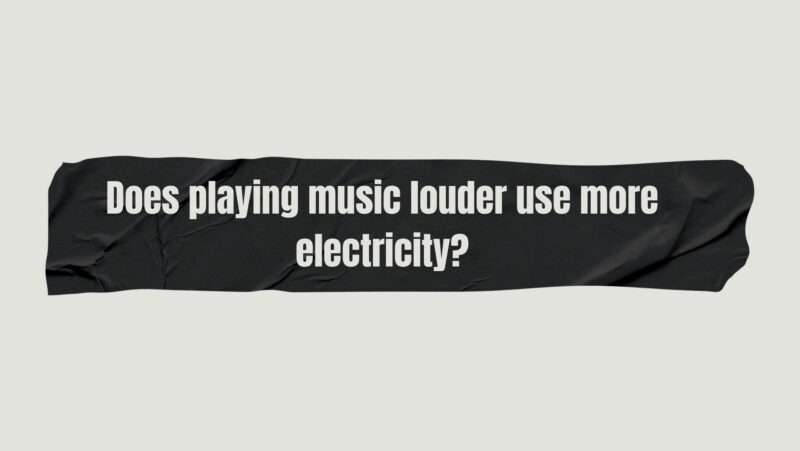In the world of music and technology, where sound and energy converge, questions about the interplay between audio experiences and electricity consumption are both pertinent and intriguing. Among these queries, one often asked is, “Does playing music louder use more electricity?” This seemingly straightforward question delves into the intricate dance between audio reproduction, amplification, and the utilization of electrical power. In this article, we embark on a journey to uncover the dynamics that govern the relationship between volume and electricity consumption during music playback.
Amplitude and Energy: The Sonic-Electric Bridge
Music, as an art form, relies on the transmission of sound waves through the air to create auditory experiences. This transmission process is facilitated by speakers and amplifiers, which convert electrical signals into sound vibrations. However, this transformation of energy from electrical to audible form inherently involves power consumption. The question of whether playing music louder consumes more electricity requires a deep dive into the mechanics of amplification and its implications.
Understanding Amplification and Power
Amplification is a cornerstone of audio technology, allowing us to achieve higher volume levels while maintaining sound quality. In simple terms, an amplifier takes a weak electrical signal and boosts it to a level suitable for driving speakers. The relationship between amplification and electricity consumption lies in the fundamental principle that increasing volume requires more power to drive the speakers and produce louder sound waves.
Volume and Power Draw: An Unbreakable Link
The correlation between playing music louder and electricity consumption is indeed established. When music is played at higher volume levels, the amplifier needs to deliver more power to generate the increased sound intensity. This translates to a higher power draw from the electrical source. Therefore, it is accurate to say that turning up the volume does result in using more electricity to fuel the amplification process.
Amplifier Efficiency: A Variable Factor
While the direct connection between volume and power draw holds true, the efficiency of the amplifier also plays a role. Modern amplifiers, especially those designed for consumer use, often incorporate technologies that optimize energy usage. Class D amplifiers, for instance, are known for their efficiency in converting electrical power into sound output, which can influence the amount of electricity used even at higher volume levels.
Content Complexity and Energy Consumption
The intricacies of the music being played also contribute to electricity consumption. Music with a wide dynamic range, encompassing quiet moments and sudden crescendos, might require the amplifier to adjust its power output frequently to maintain the desired volume. This dynamic response impacts power consumption, particularly in amplifiers with variable power modes or adaptive features.
Comparing Music Genres: A Comparative Analysis
Different music genres have varying characteristics that influence electricity consumption when played at higher volumes. Complex and dynamic genres like classical music or orchestral arrangements can lead to more fluctuations in power draw as the music shifts between quiet passages and powerful crescendos. On the other hand, genres with more consistent sound levels, such as electronic music or pop, might exhibit a steadier power draw.
Speaker Efficiency: A Key Variable
Speakers, the final link in the audio chain, also contribute to the electricity consumption equation. Speaker efficiency refers to how effectively a speaker converts electrical power into sound output. More efficient speakers require less power to achieve the same volume levels, potentially impacting the overall power consumption of the system.
Balancing Sound Quality and Energy Efficiency
While the connection between playing music louder and increased electricity consumption is evident, it’s essential to strike a balance between sound quality and energy efficiency. The pursuit of auditory pleasure should not come at the cost of excessive energy usage. This calls for a nuanced evaluation of the volume levels chosen during music playback, considering both the sonic experience and the ecological impact.
Conclusion
In the symphony of music and technology, the query of whether playing music louder uses more electricity resounds with a resounding confirmation. Amplification, the process that elevates sound intensity, is intrinsically linked to power consumption. When volume levels are increased, more power is required to drive the speakers and produce the desired sound intensity. However, this relationship is nuanced by factors such as amplifier efficiency, content complexity, music genre, and speaker efficiency.
Striking a balance between sonic pleasure and energy consciousness becomes pivotal in this exploration. While turning up the volume undoubtedly amplifies electricity consumption, modern advancements in audio technology offer the potential for efficiency without compromising sound quality. In making mindful choices about volume levels during music playback, we ensure that the harmonious blend of music and technology remains in tune with our commitment to environmental sustainability.

